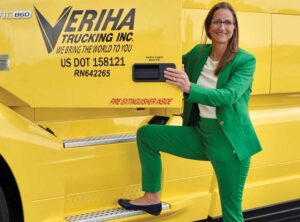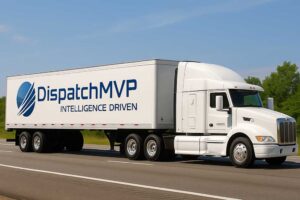As we wrap up 2023 and roll into 2024, the trucking industry faces numerous challenges — some old, some new. How is the Truckload Carriers Association (TCA) working to address the issues faced by motor carriers, service providers, and equipment manufacturers, and how can the association help its members thrive in uncertain times? The Truckload Authority team recently enjoyed a visit with TCA Chairman Dave Williams. In addition to sharing insights about regulations and policy impacting the movement of freight, he provided a sneak peek at some of the association’s plans for the future.
Good morning, Mr. Chairman, and happy New Year! As you know, it’s customary to set personal or professional goals at the beginning of a new year. What are a few of your goals for the Truckload Carriers Association in the coming year? For the trucking industry as a whole?
Earlier this year, we laid out some very ambitious goals. We have made progress in laying some of the foundational groundwork that we believe will create real value for our members. In fact, we have gone so far as shifting staff assignments and changing some of our program offerings to align with these goals. As a refresher, we stated that our aim is to:
- Improve highway safety;
- To do a better job of advocating on behalf of our drivers to improve the driving job;
- To work as an industry to improve the financial viability of motor carriers;
- To guide the truckload industry through the ever-changing environmental regulations; and
- To improve the perception and image of the truckload industry.
There are no lightweights in that group; too much is at stake to think small. Our intent would be to continue along these lines and start narrowing our focus on specific objectives that can be accomplished through the next year. I truly believe that as we start to experience wins in these areas, we will generate momentum that will spark more member involvement, and more wins. We are really not looking for surface-level wins that we can advertise. We want real wins that move the needle in our members’ businesses.
It is important to note that prioritizing our efforts within the framework of these objectives should be driven by the members of the association. So please, consider this an open invitation to engage in the process! There is a good chance that there are some different ideas, and maybe some conflicting ideas, but that’s welcome. A good, healthy debate before making a decision will almost always produce a better result.
TCA’s 2024 convention is set for March 23-26 in Nashville, Tennessee. What benefits can TCA members gain by attending the convention?
Our annual convention is really the pinnacle event of the year for the TCA. If there is one event to be involved with, it’s this one. The convention is a place where our members can really be immersed in what TCA is all about. Based on feedback received from carrier members and allied members over the past several years, our annual conference has experienced a significant makeover. We can’t wait to see everyone at Truckload 2024 in Nashville and share what we’ve been up to.
While most Truckload Authority readers are TCA members, there are a few non-members in our audience. Why should those readers consider joining TCA?
I have never really been much of a salesman. My belief has always been that the goal is to build something that brings value — something that people need. It will then sell itself. That is what we are continuing to build at TCA. We are building an organization that provides timely information, valuable educational material, best-in-class advocacy, and can’t-miss networking opportunities. We are trying to make a difference by improving the truckload industry’s impact on drivers’ families, on motor carriers, on motorists that we share the road with, on the environment, and on the nation’s supply chain. That is as meaningful as it gets in our industry. For those that want to be a part of that, it’s time to get on board and get involved. It’s pretty simple: Our strength comes from the collective strength of our members and grows with the involvement of the people within those companies.
As political debates heat up during this presidential election year, what issues should motor carriers and other trucking industry stakeholders pay particular attention to?
We have all seen the far-reaching impact government can have on our businesses. Sometimes our elected officials find ways to help us, and sometimes they make life really challenging for us. While each individual will have their own take on social issues, the issues that tend to impact our industry the most are associated with areas such as tax policy, labor policy, and the ever-growing influence of environmental policy. It is important to understand how each candidate approaches these important areas, which have real implications on our ability to successfully run our businesses. We try not to get too tied up on party politics.
The fact is that no matter which party controls the White House — or the House or the Senate — we have to work with both sides of the aisle. Our TCA lobbyists are representative of this, in that Missy Edwards is a former staff member of a Republican senator and Richard Sullivan is a top Democratic fundraiser. Both are extremely well connected within the respective parties, and both work together to help us navigate the needs of the truckload industry in Washington, D.C.
The best thing our members can do is to educate themselves on the issues of the day and let their voice be heard by voting for the candidates they feel give their family and their business the best chance to succeed. Each month the TCA publishes our Capitol Recap email to help our members stay up to date on the issues that mean the most to us. If you are not receiving this, please reach out to TCA staff. This is an important resource.
We also need our members to engage at the state and local levels, as not every government challenge has a federal solution. We have found that issues such as predatory towing, lawsuit abuse, and the spending of truck parking funds often have strong local ties. As we become aware of local issues, there are often strategies that have worked in other areas that we can share and deploy. Our strength doesn’t always come from our staff doing the work. Our real strength comes from a mobilized and motivated membership.
You wrote an insightful story last fall, which we printed, with permission, in the January/February 2024 edition of Truckload Authority. The story discusses the relationship between clean air regulations and the trucking industry. In it, you note that environmentalists seem unwilling to acknowledge the strides made to improve the efficiency of and reduce the emissions of diesel fuel. Why do you believe so many groups are focused on fuel sources other than diesel?
That is a good question. It seems society’s “cancel culture” has put petroleum on the dart board and is determined to eliminate it. But changing the world’s energy source is going to take more than just cancel culture. There is a balance of many factors that need to be considered, and some of these factors are more complex than you think. These would include energy density, energy cost, energy emissions, energy transportation costs, and energy production capabilities, among others.
Replacing petroleum “at any cost” is an extremely dangerous proposition. I am not trying to be dramatic, but such an effort could destroy our economy and put our country at a competitive disadvantage if we are not balanced in our approach. It has taken us centuries to develop petroleum-based energy into the resource the world is so dependent upon today. Wind or solar energy will take perhaps many lifetimes to fully displace petroleum, if that ends up happening. Some groups are trying to do this in the next 10 or 20 years. Rather than “canceling” diesel fuel and petroleum, we should continue to improve the use and impacts of diesel fuel — and then let these other alternative energy sources mature over a natural development cycle. We have made tremendous progress with diesel emissions and can make more progress. If it ends up that we replace diesel with another form of energy, then so be it. But we must do it in the right way, on the right timeline.
In late November, the American Transportation Research Institute (ATRI) released a report examining the issue of predatory towing in the trucking industry. How prevalent is this practice, and what regulatory steps can be taken to prevent it?
This is a big problem, as indicated by the description “predatory.” ATRI’s study states that 30% of crash related towing events are overcharged. Like any issue, many of the actors in the towing industry are doing the right thing, but there seems to be a growing number of bad actors. ATRI outlined some of the problematic practices, which include excessive hourly or per pound rates, unwarranted additional equipment or labor charges, excessive daily storage rates, vehicle release delays, and cargo release delays, among others.
Some of the situations that I am aware of could very well be described as “hostage situations.” In these cases, tow companies navigate the nuances of the local laws or local contracts and create leverage on the motor carrier. The tow company then demands an inflated fee before they release the equipment or the cargo. A growing number of cases don’t even involve an accident! More and more situations involve a tow company seizing vehicles without cause and then racking up gigantic storage charges. Minimal efforts to contact the motor carrier are made, and then the motor carrier is left to pay an outrageous fee or forfeit the equipment. It’s theft. The key for motor carriers is to actively manage every accident, overcommunicate, and document everything you do. Waiting for a tow company to send you a bill is a recipe for disaster. Motor carriers also need to leverage GPS technology to monitor their fleets and keep storage charges on vehicle seizures from racking up. The problem is that even if a motor carrier does all the right things, they still have exposure. Something needs to change here. This is a complicated issue that does not appear to have a simple solution.
Also in November, identical bills were introduced in the U.S. House and Senate calling for guaranteed overtime pay for commercial drivers. The author of the Senate bill told Truckload Authority that one goal of the legislation is to compensate drivers for excessive wait/detention time. Most drivers are paid on a cents-per-mile basis, and detention time has long been an issue for drivers and carriers. Can motor carriers legally be held responsible for delays caused by shippers and receivers?
This is a potentially touchy issue, and a classic case of “gotcha!” in politics. Who would possibly argue against drivers being paid more, right? I believe I can safely speak on behalf of the grand majority of TCA members and state that no one wants to see professional truck drivers be paid more appropriately than the motor carriers that the drivers work for. Our drivers work hard; they are the lifeblood of the supply chain. But just because we want something doesn’t automatically make it happen. There are checks and balances throughout the free-market system that require carriers to make tough decisions on how much they can pay in some areas of the business and still have enough left over to pay the bills. The truckload industry is extremely competitive, and sometimes not very rational. Our deep economic cycles reward and punish carriers on a regular basis. One significant miscalculation can put a multi-generational business at risk.
On top of that, this is an industry that has largely been commoditized. The supply chain rarely accepts higher freight rates that are not tied to supply and demand imbalances. Raising rates in order to offset higher driver compensation or any other cost, simply as a result of an increase in that cost, has proven to be a difficult thing to do consistently in this industry.
The proposed overtime bill would force additional costs on the carrier, and hope the carrier finds a way to pass on those costs to the shipper. The problem is that in a market cycle like the one we are in right now, the motor carrier would likely be expected to absorb that cost, which would likely force the carrier to manage its drivers’ time and not allow them to work past 40 hours (a week). This then becomes a case of “good intentions with unintended consequences.” Currently, our drivers have the freedom within the hours-of-service rules to work harder when they can and rest when they need to. Managing drivers in a 40-hour week would, in my opinion, not yield the result the authors of this bill are looking for. It could potentially cause the opposite result.
As for detention, this is a problem that has existed for decades. The question becomes this: Do we solve the issue through the market, or do we try to have the government solve the problem? As for the market, we seem to only make progress when the cycle swings toward the motor carriers. But as soon as the market turns towards the shipper, we seem to lose much of that progress. This is a common theme on many fronts that has plagued the truckload industry for many decades.
As for a government solution, there is always a risk of “over-engineering.” The “keep it simple” approach would be my preference. Perhaps setting a universal standard around acceptable detention periods, with the shipper/receiver compensating for any time above that (i.e. any time greater than one or two hours of waiting) would be appropriate. Government intervention beyond something simple like that leaves the possibility of more unintended consequences. I firmly believe the market should solve the majority of its own problems. We just have not been able to make lasting progress on this one.
Speaking of issues regarding driver pay, in your experience, what factors other than the amount of a paycheck can impact the relationship between a driver and motor carrier?
Pay is rightfully one of the most important factors that drivers consider when they choose who to work for. You cannot underestimate the impact of pay. At the same time, we have seen that drivers will often change jobs for an issue unrelated to pay. What makes this difficult is that each driver values the elements of a relationship in different ways. Some place a higher value on time at home, some really want to be respected, others place a high value on the “family feel” they get within a company — and the list goes on. I believe most drivers want to be part of something; they want to make a difference. They want a reason to get up in the morning, and they want to contribute in a meaningful way. They want to develop relationships that enrich their lives and grow into friendships. Pay is important, but there is more to it. The human side of the relationship goes well beyond dollars and cents. Finding the right balance of tangible pay and intangible benefits is both an art and a science. We will need to keep working on it until we get it right!
While electric Class 8 tractors have not yet been proven feasible for over-the-road, long-haul routes, they are becoming more common for first- and last-mile runs as well as for drayage at the nation’s ports. In fact, California’s Port of Long Beach is planning to build charging infrastructure that promises “high-speed” (90-minute) charging for 200 trucks a day. In real-world applications for a motor carrier, is an hour and a half a reasonable time for refueling/recharging?
Before I answer this question, I will have to repeat that I would love to see zero-emissions vehicles succeed. As an industry, we all want clean air and clean water. The challenge is that we keep seeing what I will call “misleading headlines” that make it seem that regulations such as California’s Advanced Clean Fleet Regulation are reasonable.
I have learned repeatedly throughout my career, sometimes through hard experience: 1) Things need to be kept in perspective, and 2) the details are important. Let’s talk about perspective first. The California Air Resources Board website states that “approximately 33,500 drayage trucks service California’s seaports and railyards annually.” A charging station that could accommodate 200 trucks would be, by far the largest charging site that I am aware of. But using some simple math, this would represent an infrastructure solution for less than 1% of the trucks that operate as drayage trucks in California.
The power needs and infrastructure accommodations needed to meet the demands of the Advanced Clean Fleet regulation are enormous. We would need hundreds of these facilities, and a significant number of new power plants would have to be built. Also note that the Port of Long Beach is “planning” to build this. Some of the other charging facilities that have been announced do not have completion dates for several years. This regulation begins on January 1, 2024. A company can only add a zero-emission (electric) truck to the drayage registry after January 1, 2024. If the cart hadn’t been put in front of the horse on this regulation, these charging facilities should have been in the planning stages years ago to meet the regulation requirement that is now on top of us.
As for the details, let’s talk about a 90-minute charging time. In all fairness, most manufacturers can only give an average charging time. There are so many factors to consider, such as the size of the battery, how much charge is left on the battery when you begin charging, the ambient temperature, and the age of the battery, to name a few. For “high-speed” charging scenarios, the standard disclaimer is that you can’t get to a 100% battery charge on a “high-speed” charger; normally you will only get to 80% of the available battery capacity. The remaining 20% normally takes significantly longer to charge than the first 80%. Elon Musk described this using a parking lot analogy: It’s easy to find a parking spot in an empty lot, but when the lot is full, it takes substantially longer to find a spot. In any case, this makes an already limited tractor range even more limited. The bottom line is that if you have a Class 8 truck and assume that you can get to a 100% charge in 90 minutes, you are likely to be disappointed.
As an industry, we really need to get past the flashy headlines and have some transparent dialogue about what this technology can really do and what it can’t do. For those of us that want to see zero-emissions vehicles succeed, that is the only way we are going to make progress. Because as soon as we solve the infrastructure and power generation problem, we are going to need to address the cost, the weight, and the range issues. Sounds like a good time, right? As I stated earlier, there is a lot at stake here. We need everyone to engage as this is not going to go away.
Thank you for your time, Mr. Chairman. I look forward to our next conversation.
This article originally appeared in the January/February 2024 edition of Truckload Authority, the official publication of the Truckload Carriers Association.
Linda Garner-Bunch has been with The Trucker since 2020, picking up the reins as managing editor in 2022. Linda has nearly 40 years of experience in the publishing industry, covering topics from the trucking and automotive industry to employment, real estate, home decor, crafts, cooking, weddings, high school sports — you name it, she’s written about it. She is also an experienced photographer, designer and copy editor who has a heartfelt love for the trucking industry, from the driver’s seat to the C-suite.















